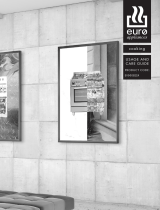
Installation and operation
A120796 17 / 26
Rules for cooking/baking
Baking in the convection oven with fan-forced air circulation
Cooking/baking process is effected with the use of hot air circulation inside the
appliance. This makes homogeneous cooking/baking possible thanks to uniform
temperature distribution.
The benefit of the convection oven is the fact that you may cook/bake various foods
(provided the temperature of processing is the same), and different aromas of the
foods do not mix.
Variable parameters of cooking/baking
Temperature
The precise temperature setting provides for correct cooking/baking of foods, both
on the outside as well as in the inside.
When the temperature is too low, the foods are more dried than baked or roasted.
On the other hand, too high a temperature may lead to burning foods from the
outside, while they remain raw in the inside (a phenomenon that is, at times,
desirable especially with meat).
Time
This variable depends on the amount of food that is prepared.
The more food, the longer cooking/baking time, and vice versa.
If a thermal processing duration is too short in comparison to the recommended
times, it is not possible to prepare food completely; if a thermal processing duration
is too long in comparison to the recommended times, the food gets burned on the
outside.
Amount
The amount of food conditions the thermal processing duration. More food requires
also longer thermal processing times, and vice versa.
Thermal processing methods
Main Courses
Lasagne, pasta gratin, and cannelloni should be baked in the temperature of 185 °C
– 190 °C. To obtain yellowish-gold crust, increase the temperature to 220 °C - 230 °C
at the end of the baking process.
Roasting
Beef, pork, chicken, turkey, lamb. To roast the meat, the roasting process requires
the temperature of 180°C. In the final phase, to dry the meat, set the temperature to
240 °C – 250 °C for a couple of minutes.




















